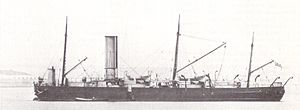HMS Royal Sovereign (1857)

HMS Royal Sovereign as she appeared as completed as a turret ship in 1864
|
|
| History | |
|---|---|
|
|
|
| Name: | HMS Royal Sovereign |
| Builder: | Portsmouth Dockyard |
| Laid down: | 17 December 1849 |
| Launched: | 25 April 1857 |
| Fate: | Broken up, May 1885 |
| Notes: | Converted to turret ship, 20 August 1864 |
| General characteristics | |
| Displacement: | 5,080 long tons (5,160 t) |
| Length: | 240 ft 6 in (73.30 m) pp |
| Beam: | 62 ft (19 m) |
| Draught: |
|
| Installed power: | 2,460 ihp (1,830 kW) |
| Propulsion: | Sails; One-shaft Maudslay return connecting-rod steam engine , giving 2,460 indicated horsepower (1,830 kW) |
| Speed: | 11 kn (20 km/h; 13 mph) |
| Complement: | 300 officers and men |
| Armament: |
|
| Armour: |
|
HMS Royal Sovereign was originally laid down as a 121-gun first-rate ship of the line of the Royal Navy. She would have mounted sixteen 8 in (200 mm) cannon, 114 32-pounder (15 kg) guns, and a 68-pounder (31 kg) pivot gun. With the rise of steam and screw propulsion, she was ordered to be converted on the stocks to a 131-gun screw ship, with conversion beginning on 25 January 1855. She was finally launched directly into the ordinary on 25 April 1857. She measured 3,765 long tons (3,825 t) burthen, with a gundeck of 240 feet 6 inches (73.30 m) and breadth of 62 feet (19 m), and a crew of 1,100, with engines of 780 nhp.
After several years of inactivity, she was selected for conversion into an experimental turret ship instigated by Captain Cowper Coles, who believed that a mastless ship armed with turret-mounted guns was the best possible design for a coast-defence ship. When this conversion was completed 20 August 1864, she was the first British turret-armed ship, and the only one with a wooden hull. The order to proceed with the conversion was issued on 4 April 1862.
She was razed down to the lower deck, leaving her with between 7 and 8 feet (2.1 and 2.4 m) of freeboard. The decks and hull sides were strengthened to carry the planned armament, and to absorb the force when the guns were fired. There was some delay when it was found that she had been cut down too far, necessitating some re-building of the sides. On completion her length-to-beam ratio was slightly under 4:1, which was the smallest ever ratio used in British armoured ships.
The original design included five turrets, each containing either two 68-pounder smoothbore or one 100-pounder (45 kg) smoothbore cannon. This was modified to a four-turret configuration, with one 164 long tons (167 t) twin turret, and three 150 long tons (150 t) single turrets. The initial guns carried were 10 1⁄2-inch (270 mm) smoothbores that fired a 150-pound spherical steel shot. In 1867 they were all replaced by 9-inch (230 mm) muzzle-loading rifles.
On 15 January 1866 three shots were fired at close range against the after turret of Royal Sovereign by one of the 9-inch (230 mm) guns carried by HMS Bellerophon to evaluate how well Coles' turrets held up to gunfire. While the armour plates of the turret were displaced, and one shot pierced the back of the turret, the ability of the turret to turn and the guns to fire was not impaired.
...
Wikipedia
